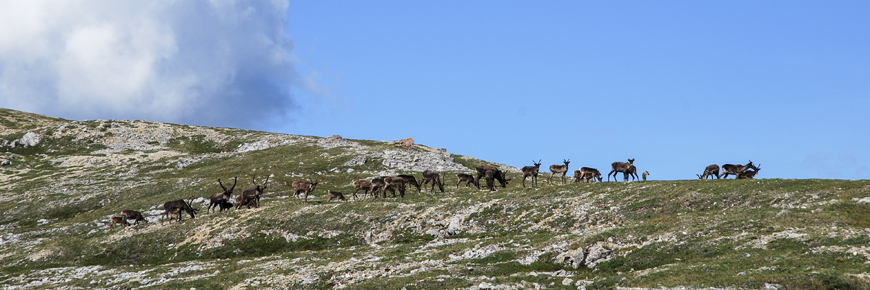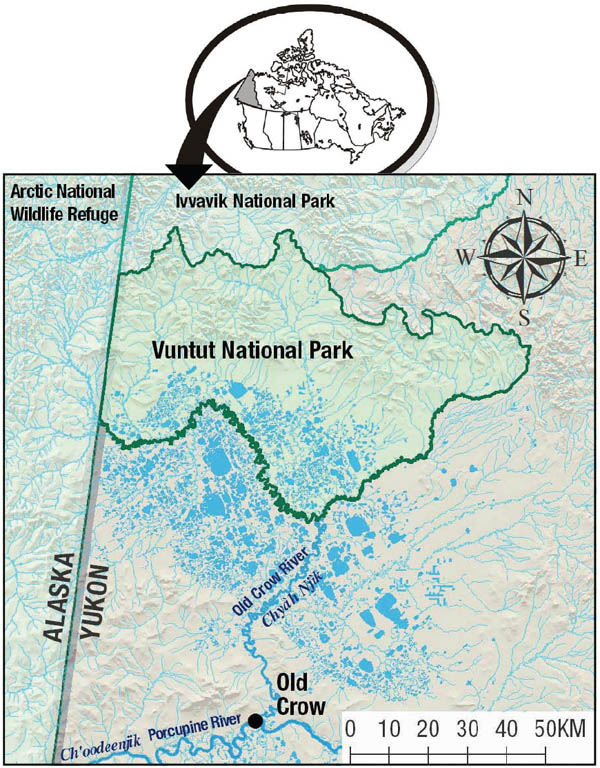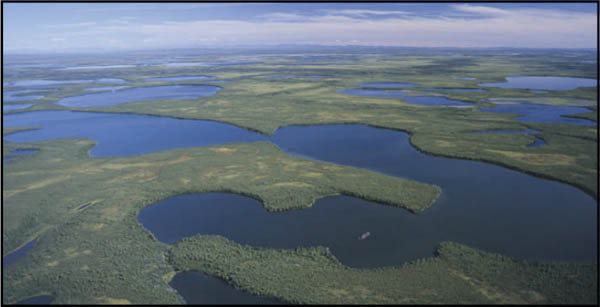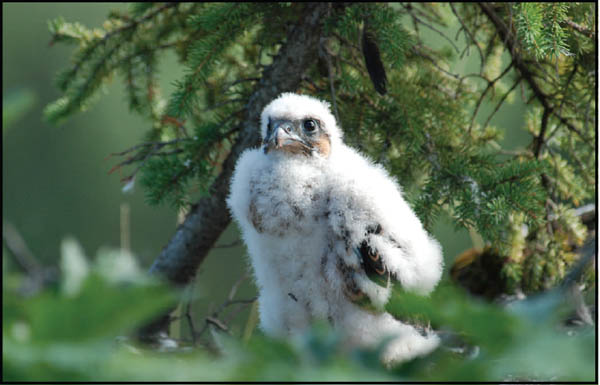
Designation information
Vuntut National Park

Vuntut is pronounced "Vuhn-tuht"
Location
Vuntut National Park is located in Yukon's far north next to the Alaskan border. To its north is Ivvavik National Park; and Alaska's Arctic National Wildlife Refuge is to the west. The closest community is Old Crow, home to the Vuntut Gwitchin First Nation, who cooperatively manage the park with Parks Canada. Both the park and Old Crow are accessible by air only.
Climate
Vuntut National Park has an arctic continental climate—more extreme than Ivvavik National Park to its immediate north because it lacks the moderating influence of the ocean. The Old Crow Flats area in Vuntut experiences some of the coldest winter conditions in Yukon, with average January temperatures of –30°C and extremes approaching –60°C, while in summer it can be warmer than in southern Yukon (July average 15°C). Vuntut has a dry climate, with only 200-300mm of precipitation annually. It is located in the Taiga Cordillera Ecozone.
Climate change is a pressing concern for the Vuntut Gwitchin people, whose traditional territories include the park, and who still depend on the migratory Porcupine caribou herd for sustenance. Winter temperatures have increased about 5°C in recent decades, and summers are considerably wetter.

Geology
The park has two contrasting regions. The Old Crow Flats in the southern part feature 2000 shallow lakes set among peat bogs. The name Vuntut means "among the lakes" in the Gwich'in language. Further north are the rolling foothills and scattered peaks of the British Mountains. The last phase of mountain building in the area was 60 million years ago.
An important aspect of the park's geology is that it is part of Beringia—i.e. it was never glaciated during the Pleistocene ice ages. Spared from the destructive force of glaciers, hundreds of thousands of fossils are preserved in the permafrost of the Old Crow basin, including those of extinct animals like the woolly mammoth. The park's V shaped valleys formed by rivers are typical of non-glaciated landscapes.
Vegetation
Vuntut can be divided into several distinct ecosystems with distinct plant communities. Taiga, i.e. open spruce forests, is found at lower elevations—trees are small black and white spruce; shrubs include willow and Labrador tea. Tundra dominates the hills: tussocks formed of sedges and mosses, various heaths, and mountain avens. During the short summer season, arctic and alpine wildflowers bloom in profusion. In the wetlands, black spruce, dwarf birch, willow, cotton grass, lichen and moss surround the shallow lakes.

Wildlife
The Old Crow Flats are vital nesting and summer habitat for a half million migratory waterfowl, including tundra swans, greater white-fronted geese, white-winged and surf scoters, goldeneye, scaup, teal, pintail and canvasback. The Ramsar Convention includes Old Crow Flats in its list of globally important wetlands. The Flats are also ideal habitat for muskrat, a major traditional harvest of the Vuntut Gwitchin.
The Porcupine caribou herd, numbering 169,000 animals (in 2010), migrates through the park or adjacent areas in spring and fall. Moose spend summer in the Flats and seek shelter in the surrounding hills during winter.
Predators include wolf, grizzly bear, lynx, fox, wolverine and mink, as well as golden eagle, gyrfalcon and peregrine falcon.
Activities
Vuntut National Park offers a range of opportunities for the experienced backcountry traveller, from canoeing the Old Crow River, to hiking in the mountainous part of the park, to winter ski touring. Visiting Vuntut National Park is challenging: you must be completely self-sufficient. There are no facilities or developed trails in the park, and access is by air (or a multi-day overland or river journey).
The John Tizya Centre in Old Crow gives visitors a warm Vuntut Gwitchin welcome. Learn about Vuntut National Park's ecology and culture as you enjoy the Centre's beautiful exhibits and artifacts.
For more information:
Vuntut National Park
Suite 205 - 300 Main Street
Whitehorse, YT
Y1A 2B5
Telephone: 867-667-3903
Fax: 867-393-6701
E-mail: whitehorse.info@pc.gc.ca
Related links
- Date modified :